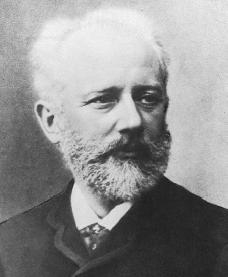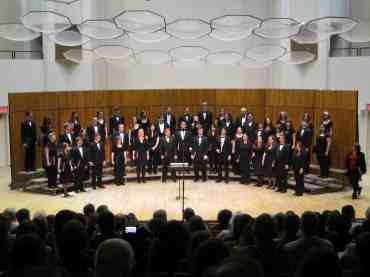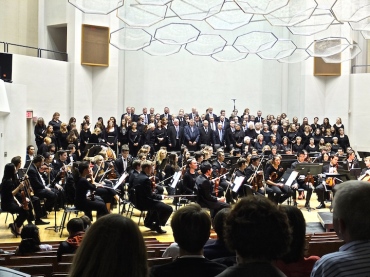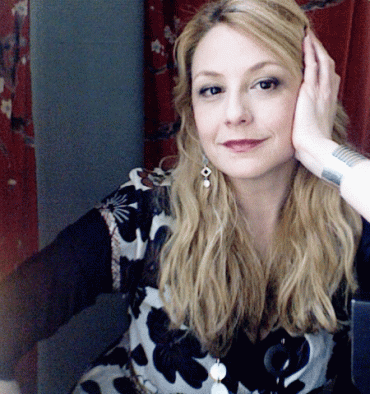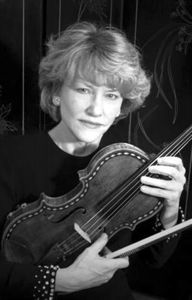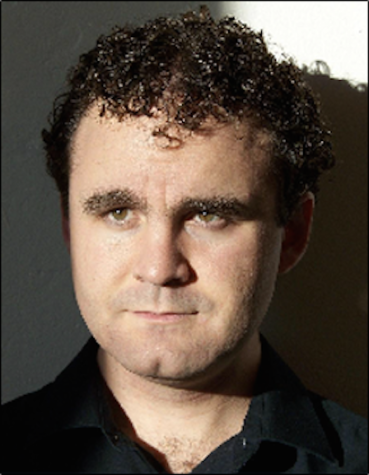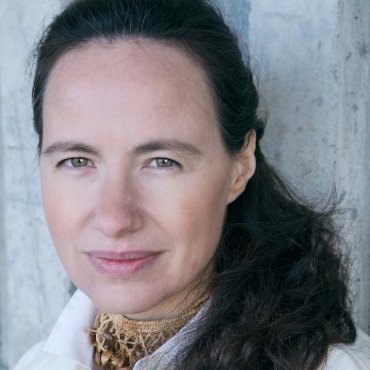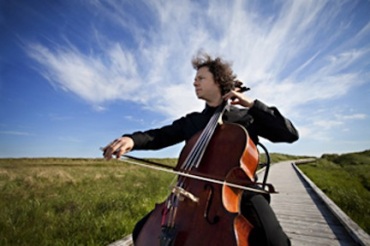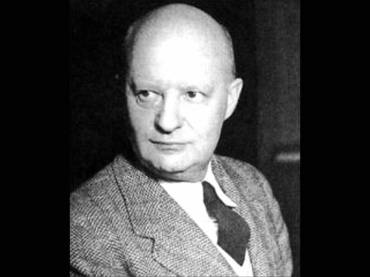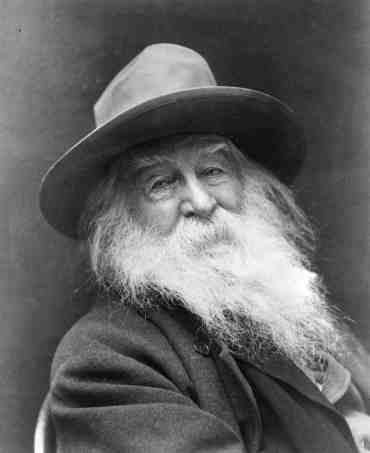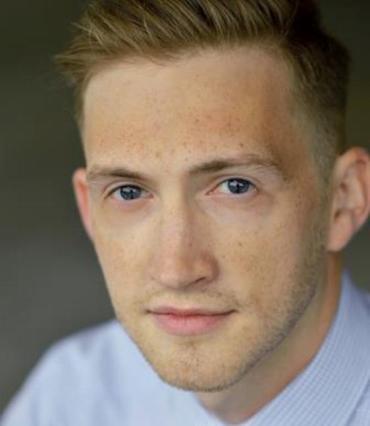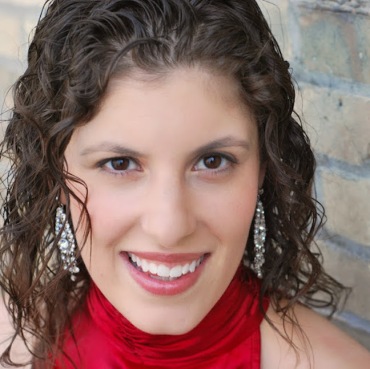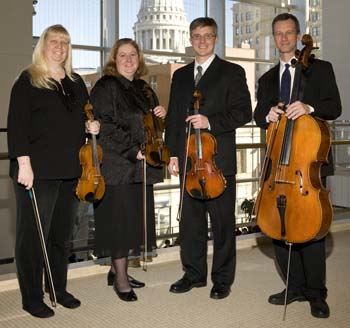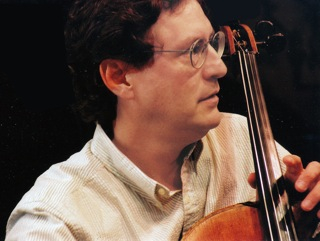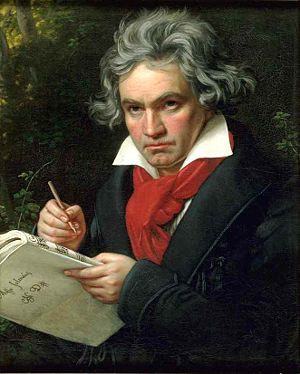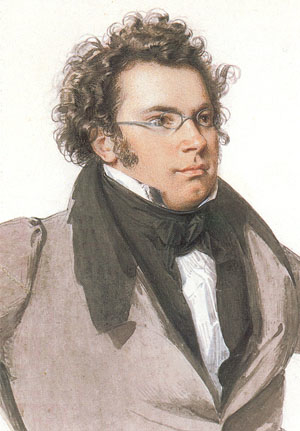The Well-Tempered Ear
YOU MUST HEAR THIS: No piece captures the mixed emotions of Memorial Day better than Charles Ives’ “Decoration Day”
3 Comments
PLEASE HELP THE EAR. IF YOU LIKE A CERTAIN BLOG POST, SPREAD THE WORD. FORWARD A LINK TO IT OR, SHARE IT or TAG IT (not just “Like” it) ON FACEBOOK. Performers can use the extra exposure to draw potential audience members to an event. And you might even attract new readers and subscribers to the blog.
By Jacob Stockinger
Today is Memorial Day, 2022.
It is the annual holiday to remember those who died in military service to the country. (Below are flags placed each year at the tombstones in Arlington National Cemetery in Virginia.)
If you want to honor survivors and current service members, that would be Veterans Day on Nov. 11.
All weekend long the radio has been playing music and the television has been showing war movies.
A lot of the music is familiar and repeated every year: Sousa marches and Morton Gould suites, elegies by Gustav Mahler, Samuel Barber, Aaron Copland and Leonard Bernstein; requiems by Mozart and Fauré; a hymn by John Williams and other movie scores. This year has also seen the playlist include rediscovered works of homage by African-American composers such as William Grant Still.
But only this year did The Ear finally hear — thanks to Wisconsin Public Radio — the one piece that, to his mind, best captures Memorial Day with its blending of consonance and dissonance, its mix of major and major keys, of familiar or “found” music and original music.
It is called, simply, “Decoration Day” and it was composed in 1912 — but not published until 1989 — by the 20th-century iconoclastic and early modernist American composer Charles Ives (below, 1874-1954). It ended up as part of a work the composer called “A Symphony: New England Hollidays.”
See if you agree with The Ear.
Listen to the 8-minute performance by “The President’s Own” United States Marine Band in the YouTube video at the bottom.
Listen to the deep anguish and and sense of loss conveyed in the opening, when a solemn remembrance procession goes to a cemetery to plant flags and lay flowers and wreaths to “decorate” the graves of the fallen.
Listen carefully and you will hear a faint version of “Taps” and ringing church bells in the atmospheric music.
Then as so often happens in reality, life suddenly intrudes in the form of a celebration by a loud marching brass band as it leaves the cemetery for the celebratory marches, picnics and fireworks.
But at the end, the darkness briefly returns. The sense of loss lingers long after the actual death and long after the holiday has been celebrated.
There is no closure.
Just resignation.
Just living with loss.
Here is the background from Wikipedia about how the holiday started as Decoration Day after the Civil War and when it evolved into Memorial Day in 1970: https://en.wikipedia.org/wiki/Memorial_Day
And here is biographical background, with the actual sources and depictions of “Decoration Day” — just go down the page to compositions and click — about Charles Ives: https://en.wikipedia.org/wiki/Charles_Ives
Did you know and like Charles Ives’ music?
Does “Decoration Day” impress or move you?
What music most embodies Memorial Day for you?
The Ear wants to hear.
Tags: #AaronCopland, #African-AmericanComposer, #ArlingtonNationalCemetery, #BandMusic, #BlackAmericans, #BlogPost, #BlogPosting, #BrassBand, #BrassMusic, #CharlesIves, #ChurchBells, #CivilWar, #DecorationDay, #FacebookPosting, #GabrielFaure, #GustavMahler, #JacobStockinger, #JohnPhilipSousa, #JohnWilliams, #LeonardBernstein, #MajorKey, #MemorialDay, #MilitaryService, #MinorKey, #MixedEmotions, #MortonGould, #NationalPublicRadio, #NewEngland, #OrchestralMusic, #OriginalWork, #SamuelBarber, #TheEar, #ThePresident, #TheU.S., #UnitedStates, #UnitedStatesMarineBand, #USMarines, #VeteransDay, #WarMovies, #Wikipediaentry, #WilliamGrantStill, #WisconsinPublicRadio, #WolfgangAmadeusMozart, #YouTubevideo, 20th-century, 20th-century music, Aaron Copland, actual, African American, American, American Civil War, Ameriuca, anguish, annual, Arlington, Arlington National Cemetery, Arts, atmosphere, atmospheric, audience, background, band, band music, Barber, Bernstein, biographical, black, blog, bottom, brass band, brass music, celebration, celebratory, cemetery, Charles Ives, church, church bells, Civil War, Classical music, Classical Revolution, closure, compose, composer, Composition, Concert, consonance, Copland, darkness, dead, death, Decoration Day, deep, depiction, dissonance, early, Early music, Elegy, embody, emotion, evolution, evolve, Facebook, fallen, familiar, Fascebook, Faure, film, Fireworks, flag, flower, found, Gabriel Fauré, Gould, grave, Gustav Mahler, hear, Holiday, homage, honor, hymn, iconoclast, iconoclastic, impress, information, intrude, Ives, Jacob Stockinger, John Philip Sousa, John Williams, Leonard Bernstein, life, like, linger, listen, living, loss, loud, Mahler, major key, march, Marines, mark, Memorial Day, military, minor key, minute, mixed, modern, modernist, morph, Morton Gould, move, Movies, Mozart, nation, national, National Public Radio, New England, NPR, opening, orchestral, original, performance, picnic, piece, plant, playlist, post, posting, President, procession, psalm, publish, Radio, reality, rediscover, remembrance, repeat, Samuel Barber, score, sense, service, show, solemn, soundtrack, source, sources, Sousa, Still, suddenly, Suite, symphony, Taps, Television, thanks, The Ear, TV, U.S., United State Marine Band, United States, veterans, Veterans Day, video, war, war movies, weekend, Wikipedia, William Grant Still, Williams, wisconsin public radio, Wolfgang Amadeus Mozart, work, wreaty, year, you, YouTube
Classical music: University Opera succeeded brilliantly by setting Britten’s “A Midsummer Night’s Dream” in the 1960s at Andy Warhol’s The Factory
2 Comments
PLEASE HELP THE EAR. IF YOU LIKE A CERTAIN BLOG POST, SPREAD THE WORD. FORWARD A LINK TO IT OR, SHARE IT or TAG IT (not just “Like” it) ON FACEBOOK. Performers can use the extra exposure to draw potential audience members to an event. And you might even attract new readers and subscribers to the blog.
By Jacob Stockinger
Larry Wells — the Opera Guy for this blog – took in two performances last weekend of the University Opera’s production of Benjamin Britten’s “A Midsummer Night’s Dream,” which played to three sold-out houses at Music Hall. He filed this review. Performance photos are by Benjamin Hopkins and Michael Anderson.
By Larry Wells
The University Opera’s production of Benjamin Britten’s “A Midsummer Night’s Dream” was set in Andy Warhol’s Factory of the 1960s with countertenor Thomas Alaan (below) as a Warhol-like Oberon presiding over the antics.
The opera by Britten (below) follows Shakespeare’s play fairly closely. The magical transformations and herbs of the original were translated to a hallucinogen-filled milieu of go-go dancing fairies, master-slave relationships and same-sex liaisons.
And for me it worked. That is to say, this production contained the same strangeness and wonder as the traditional productions I have seen. The play itself is very strange and wonderful.
Alaan is a fine singer and played a manipulative and somewhat slimy Warhol/Oberon whose flat affect seemed to be reflected in the relative lack of expressivity in the voice. Pitted against Oberon were Amanda Lauricella and Kelsey Wang alternating as Tytania.
Although the program stated that the portrayal of Tytania was loosely based on Edie Sedgwick in this production, without the platinum hair I missed the references. Both portrayals were much more assertive than Edie ever was, and both singers’ ardent coloratura voices tended to overshadow Oberon’s, which may have been intentional. Wang (below, far right) was an intense actress who put sparks into her portrayal, while Lauricella really has a superb voice.
(Below, from left, are Michael Kelley as Puck; Thomas Alaan as Oberon; Tanner Zocher as a young man; and Kelsey Wang as Tytania.)
The four lovers (below left) seemed to be employees at The Factory. Tenor Benjamin Liupaogo portrayed Lysander. The vocal part has an uncomfortable upper range, but Liupaogo’s singing in the second act particularly was up to the challenge.
His rival Demetrius was portrayed by baritone Kevin Green. Their contending affections for Hermia and Demetrius’ initial scorn for Helena were oddly lacking in ardor.
Hermia was double cast with Julia Urbank, a promising soprano, and Chloe Agostino, who was also a very good singer. Poor Helena, first ignored and then pursued by both men, was also double cast with a terrific Rachel Love and an equally gifted Jing Liu.
(The four lovers, below from left, were: Benjamin Liupaogo as Lysander; Chloe Agostino as Hermia; Jing Liu as Helena;, Kevin Green as Demetrius; and Paul Rowe as Theseus with Lindsey Meekhof as Hippolyte.)
As I have noted before, the female singers in the opera program often seem to be very solid performers. (You can hear the lovers’ quartet in the YouTube video at the bottom.)
And then there were the “Rustics” (below), the workers who have come together to put on the play “Pyramus and Thisbe” for the upcoming wedding of the local duke, or in this case a rich art patron.
(The six rustics, below from left, were: James Harrington as Bottom; Jacob Elfner as Quince; Benjamin Galvin as Snug; Jack Innes as Starveling; Thore Dosdall as Flute; Jeffrey Larson as Snout; with Kevin Green as Demetrius, seated.)
The six men were each talented comic actors and provided many of the performance’s laughs. Foremost was James Harrington’s Bottom. Not only a very funny actor, he produced in my opinion the finest singing among the many talented students.
Mention must be made of the very amusing Flute, hysterically portrayed by Thore Dosdall, and the promising bass Benjamin Galvin as the slow learner Snug.
These men not only sang well together and separately, but also provided many guffaws whenever they appeared. (Below are: Jacob Elfner as Quince; Jeffrey Larson as Snout; James Harrington as Bottom; Jack Innes – back row up on box – as Starveling; Benjamin Galvin as Snug; and Thore Dosdall as Flute.)
Additionally we had the fairies — all female voices in this production — who sounded wonderful together and got to demonstrate their incongruous ‘60s dance moves to Britten’s score.
Professor Paul Rowe (below left, with Lindsey Meekhof as Hippolyta) made an appearance as Theseus, the duke. His singing was that of a mature artist, a quality to which the students are clearly aspiring.
As the opera drew to a close with a beautifully harmonious chorus, one felt the transformation from dissonance to harmony in the opera and conflict to resolution embodied in the original play.
Many mentions of woods and forest are made in the libretto. Director David Ronis had the walls of the factory cleverly hung with changing arrays of Warhol-like multiple images of flowers and animals. With the amount of weed being smoked and who knows what being ingested onstage, it was easy to believe that the characters might think they were in a forest despite being in a Manhattan warehouse (below).
(The cast, below from left, included Amanda Lauricella and Thomas Alaan in the foreground as Tytania and Oberon. Others were: Julia Urbank on the floor; Benjamin Liupaogo, on the floor; Chloe Flesch; Maria Steigerwald; Amanda Lauricella; Maria Marsland; Angela Fraioli; Thomas Aláan; and James Harrington lying on the couch.)
Presiding over all of this were members of the UW Symphony Orchestra led by new conductor Oriol Sans (below). I have heard maestro Sans conduct the students several times this fall, and I feel he is an outstanding addition to the music school. His control over the forces was amazing, and the subtlety he drew from the players was remarkable.
Ronis (below, in a photo by Luke Delalio) has tried original twists in several of his previous productions, but I think this has been the most outlandish. And I have to say that I really loved it. So carry on, please.
He has a penchant for Britten, one of my favorite composers. His previous productions included “Albert Herring” and “Turn of the Screw.” I wonder if readers have suggestions for another Britten opera he could conceivably produce here. I have my own wish list.
Tags: #AlbertHerring, #AMIdsummerNight'sDream, #AndyWarhol, #ArtPatron, #BaritoneSinger, #BenjaminBritten, #BenjaminLiupaogo, #BlogPost, #BlogPosting, #BlogReview, #ChoralMusic, #CountertenorSinger, #DavidRonis, #DrugsandAlcohol, #EdieSedgwick, #EmeritusProfessor, #FacebookPost, #FacebookPosting, #LarryWells, #Master-Slave, #MeadWitterSchoolofMusic, #MusicHall, #MusicReview, #MusicSchool, #OrchestralAccompaniment, #OriolSans, #PaulRowe, #PopArt, #SopranoSinger, #TenorSinger, #The1960s, #TheaterReview, #TheEar, #TheFactory, #TheOperaGuy, #TurnoftheScrew, #UniversityofWisconsin-Madison, #UniversityOpera, #UWProfessor, #UWSymphonyOrchestra, #VocalMusic, #WilliamShakespeare, #WishList, #YouTubevideo, 1960s, A Midsummer Night's Dream, Actor, actress, affect, affection, Albert Herring, alcohol, amazing, Andy Warhol, animal, antics, ardent, Art, art patron, artist, Arts, aspire, assertive, baritone, beautiful, Benjamin Britten, Benjamin Liupaogo, blog, Britten, cast, challenge, characters, choral music, chorus, Classical music, coloratura, comic, composer, conductor, conflict, contend, control, countertenor, dance, dancing, David Ronis, director, dissonance, dream, drugs, duke, Edie Sedgwick, employee, expressivity, Facebook, factory, fairies, fairy, favorite, females, flat, flowers, forces, forest, forward, funny, gifted, go-go, guffaw, hair, hallucinogens, harmonious, harmony, herb, herbs, House, houses, hysterical, image, incongruous, ingest, intense, Jacob Stockinger, Larry Wells, laughs, learner, liaison, libretto, like, link, local, lover, Madison, magic, magical, male, MANHATTAN, manipulative, mature, Mead Witter School of Music, member, men, mention, milieu, move, Music, Music Hall, music review, music school, Oberon, onstage, opera, opera music, Orchestra, original, Oriol Sans, outlandish, outstanding, overshadow, patron, Paul Rowe, penchant, photos, platinum, play, pop, Pop art, portrayal, post, posting, preside, presiding, produce, produced, production, professor, promising, Puck, quality, range, reference, relationship, remarkable, resolution, rich, rustic, same-sex, score, scorn, Shakespeare, share, sing, singer, Singing, slimy, smoke, sold-out, soprano, sparks, strange, strangeness, subtlety, suggest, suggestion, summer, superb, tag, talent, talented, terrific, The Ear, The Factory, The Opera Guy, theater review, traditional, transformation, Transformations, translated, Turn of the Screw, twist, Tytania, uncomfortable, United States, University of Wisconsin-Madison School of Music, University of Wisconsin–Madison, University Opera, upper, UW, UW Symphony Orchestra, UW-Madison, UW-Madison Mead Witter School of Music, video, vocal music, voice, wall, warehouse, Warhol, wedding, weed, William Shakespeare, Wisconsin, wish list, women, wonder, Woods, workers, YouTube
Classical music: The eclectic fusion group Mr. Chair plays music by Stravinsky, Satie and others on Monday night in Spring Green
Leave a Comment
IF YOU LIKE A CERTAIN BLOG POST, PLEASE SPREAD THE WORD. FORWARD A LINK TO IT OR, SHARE IT or TAG IT (not just “Like” it) ON FACEBOOK. Performers can use the extra exposure to draw potential audience members to an event. And you might even attract new readers and subscribers to the blog.
By Jacob Stockinger
The Ear has received the following announcement from the Rural Musicians Forum:
Mr. Chair looks like a jazz quartet, sounds sometimes like a rock band, but in actuality is a contemporary classical music group in the guise of a modern band.
Classically trained musicians who are well versed in jazz, the players in Mr. Chair create a new sound using both acoustic and electric instruments.(You can hear Mr. Chair perform the original composition “Freed” in the the YouTube video at the bottom.)
The Rural Musicians Forum audience will have the chance to enjoy the soundscapes of this fascinating eclectic fusion group on this coming Monday night, Aug. 19, at 7:30 p.m. at Taliesin’s Hillside Theater (below) in Spring Green.
Members of Mr. Chair (below) are Professor Mark Hetzler, trombone and electronics; Jason Kutz, piano and keyboards; Ben Ferris, acoustic and electric bass; and Mike Koszewski, drums and percussion. All have close ties to the University of Wisconsin-Madison’s Mead Witter School of Music, where they also perform as an ensemble.
Mr. Chair’s compositions are long-form journeys, telling stories through sound by using and exploring the three pillars of music: melody, harmony and rhythm. Think cinematic, orchestral, surreal, romantic, emotional and gripping, and always equal parts dissonant and consonant. Their influences are far-reaching from classical, blues and rock to soul, funk, jazz and beyond.
For this concert, Mr. Chair will perform re-imagined excerpts from Igor Stravinsky’s Neo-Classical ballet masterpiece Pulcinella as well as music by Erik Satie and selections from their debut album, NEBULEBULA, which will be released on Thursday, Sept. 5, on vinyl, CD and digital streaming platforms.
The genre-bending quartet will perform in the beautiful Hillside Theater designed by Frank Lloyd Wright as part of his Taliesin compound. It is located at 6604 State Highway 23, about five miles south of Spring Green.
Admission is by free will offering, with a suggested donation of $15.
Tags: #BalletMusic, #BalletScore, #BenFerris, #BlogPost, #BlogPosting, #BluesMusic, #ChamberMusic, #ChamberMusician, #CompactDisc, #ContemporaryMusic, #DrumMusic, #EqualParts, #ErikSatie, #FacebookPost, #FacebookPosting, #FrankLloydWright, #FreewillOffering, #FunkMusic, #HillsideTheater, #IgorStravinsky, #JasonKutz, #JazzMusic, #MarkHetzler, #MeadWitterSchoolofMusic, #MikeKoszewski, #Mondaynight, #NewMusic, #PercussionMusic, #PulcinellaSuite, #RockandRoll, #RockBand, #RockMusic, #RuralMusiciansForum, #SoulMusic, #SpringGreen, #TheBlues, #TheEar, #TromboneMusic, #UniversityofWisconsin-Madison, #YouTubevideo, acoustic, admission, Album, Arts, audience, ballet, band, Baroque, Ben Ferris, blog, blues, CD, Chamber music, chance, cinematic, Classical, Classical music, classicalmusic, close, Compact Disc, composer, Composition, compound, Concert, consonance, consonant, contemporary, create, debut, design, digital, dissonance, dissonant, drum, eclectic, electric, electronics, emotional, ensemble, equal, equal parts, Erik Satie, explore, Facebook, fascinating, forum, forward, Frank Lloyd Wright, freed, funk, fusion, gripping, group, guise, harmony, highway, Hillside Theater, Igor Stravinsky, imagine, influence, instrument, Jacob Stockinger, Jason Kutz, Jazz, Keyboard, like, link, long-form, Madison, Mark Hetzler, masterpiece, Mead Witter School of Music, melody, member, Mike Koszewski, modern, Monday, Mr Chair, Music, Musician, neo-Classical, new, New Music, night, offering, orchestral, original, part, percussion, performer, Pianist, Piano, pillar, platform, players, post, posting, Pulcinella, Pulcinella Suite, Quartet, rhythm, Rock, rock and roll, rock band, Romantic, rual, rural, Rural Musicians Forum, share, soul, Sound, soundscape, Spring Green, state, stories, story, streaming, subscriber, surreal, tag, Taliesin, The Ear, tie, Trombone, United States, University of Wisconsin-Madison School of Music, University of Wisconsin–Madison, use, UW-Madison, vinyl, word, YouTube
Classical music: The UW-Madison’s Pro Arte Quartet opens its new season in top form
Leave a Comment
IF YOU LIKE A CERTAIN BLOG POST, PLEASE FORWARD A LINK TO IT OR SHARE IT (not just “Like It”) ON FACEBOOK. Performers can use the extra exposure to draw potential audience members to an event.
By Jacob Stockinger
On Friday night in Mills Hall, in an all-masterpiece program that featured Classical, Romantic and Modernist works, the University of Wisconsin-Madison’s Pro Arte Quartet (below, in a photo by Rick Langer) opened its new season .
And it did so in top form. The Ear came away with one thought: You just can’t find better chamber music in Madison — and it’s free!
In the “Sunrise” Quartet in B-flat Major, Op. 76, No. 4, by Franz Joseph Haydn, the Pro Arte exhibited the ideal Classical style with its balance, voicing and clarity.
The sunrise motif proved utterly convincing and evocative. Particularly noteworthy was how the group highlighted the dissonances in the Classical era’s slow movement. (Hear it in the YouTube video at the bottom.)
The interpretation offered more proof that when the work is consonant, you play for the dissonance; and when the work is dissonant, you play for the consonance.
In the short, non-stop Quartet No. 7 in F-sharp minor, Op. 108, by Dmitri Shostakovich, The Ear was impressed by how the Pro Arte teased out the remnants of late Russian Romanticism that creep into the mostly modernist works of Shostakovich and Prokofiev.
Also remarkable was how the Pro Arte highlighted the structure and counterpoint that Shostakovich, a devotee of Bach, brought to his modernism. This seemed a softer and more lyrical Shostakovich, less strident or percussive, than you often hear. And the approach worked beautifully to engage the listener.
And then came the grand finale done grandly: the late Beethoven Quartet No. 15 in A minor, Op. 132. The quartet unraveled the often perplexing and thick texture; the epic length; and the forward-looking compositional methods.
The Pro Arte used a low-key and restrained approach that only highlighted the heart-rending lyricism of the “Heiliger Dangesang,” or Sacred Hymn of Thanksgiving, that the aging Beethoven composed when he had recovered from what he thought might be a fatal illness.
How fitting! The perfectly planned program started with one dawn by the teacher and ended with another dawn by the student.
Madison keeps getting more new chamber music groups, all very accomplished and all very good. But the Pro Arte Quartet — now in its 106th season of existence and its 78th season in residence at the UW-Madison — is still tops. As one fan said in near disbelief, “That concert was out of this world.” He wasn’t alone as the performance drew a prolonged standing ovation and loud bravos from the two-thirds house.
When it comes to chamber music, you just can’t do better than the Pro Arte Quartet. It’s that simple. With such quality and affordability, the Pro Arte should always be playing to a full house.
The Pro Arte Quartet will repeat the same program on Sunday afternoon, Oct. 7, at 12:30 p.m. for “Sunday Afternoon Live at the Chazen.” Admission to the Brittingham Gallery 3 performance space is free, and the concert will be streamed live. Go here for details and a link:
And the dates and times — without programs — of future Pro Arte Quartet concerts can be found here: https://www.music.wisc.edu/pro-arte-quartet/
Tags: #BlogPost, #BlogReview, #ChamberMusic, #ChazenMuseumofArt, #Classicalcomposer, #Classicalera, #DmitriShostakovich, #FacebookPost, #Forward-Looking, #FranzJosephHaydn, #JohannSebastianBach, #LateRomanticism, #LudwigVanBeethoven, #MillsHall, #MusicalInterpretation, #MusicalPerformance, #ProArteQuartet, #RomanticComposer, #RomanticMusic, #RussianRomanticism, #SacredHymn, #SacredHymnofThanksgiving, #SergeiProkofiev, #SlowMovement, #StandingOvation, #StringQuartet, #SundayAfternoonLiveattheChazen, #SunriseQuartet, #TheEar, #TopForm, #UniversityofWisconsin, #UniversityofWisconsin-Madison, #YouTubevideo, aging, artist-in-residence, Arts, audience, Bach, balance, Baroque, Beethoven, blog, bravo, cellist, Cello, Chamber music, clarity, Classical era, Classical music, classicalmusic, composer, Composition, Concert, consonance, consonant, counterpoint, date, devotee, disbelief, dissonance, dissonant, Dmitri Shostakovich, epic, event, existence, Facebook, fatal, free, future, Haydn, House, hymn, ideal, illness, interpretation, Jacob Stockinger, Johann Sebastian Bach, length, Ludwig van Beethoven, lyrical, Madison, masterpiece, method, Mills Hall, modernism, motif, Music, noteworthy, ovicative, percussive, performance, post, posting, Pro Arte Quartet, program, Prokofiev, remnant, residence, restrained, restraint, Russian, sacred, Slow movement, softer, space, streaming, strident, String quartet, structure, sunrise, tease, texture, Thanksgiving, The Ear, thought, time, top form, United States, University of Wisconsin-Madison School of Music, University of Wisconsin–Madison, Viola, Violin, violinist, violist, voicing, Wisconsin, work, world, YouTube
Classical music: Is Prokofiev more Romantic than modernist? Hear for yourself at the concert Friday night by the Wisconsin Chamber Orchestra and violinist Giora Schmidt. Plus, the UW Symphony Orchestra performs a FREE concert Thursday night
Leave a Comment
ALERTS: This Thursday night at 7:30 p.m. in Mills Hall, the UW-Madison Symphony Orchestra will perform a FREE concert under the baton of alumnus and guest conductor Mikko Rankin Utevsky, the founder and director of the Madison Area Youth Chamber Orchestra (MAYCO). The program features the Symphony No. 5 by Franz Schubert; “Entr’acte” by Caroline Shaw; and the “Holberg Suite” by Edvard Grieg.
The week’s FREE Friday Noon Musicale at the First Unitarian Society of Madison, 900 University Bay Drive, features guitarist Steve Waugh and flutist Sridhar Bagavathula playing music by Frederic Chopin, Heitor Villa-Lobos, Astor Piazzolla, Francisco Tarrega, Francois Morel and Jerome Kern. The concert runs from 12:15 to 1 p.m.
By Jacob Stockinger
Sometimes the frame helps to define the picture, to reveal or at least reinforce the picture’s meaning.
Such is the case with this Friday night’s appealing and stand-out concert by the Wisconsin Chamber Orchestra with conductor Andrew Sewell and Israeli violin soloist Giora Schmidt (below, in a photo by David Getzschman).
The concert is at 7:30 p.m. in The Capitol Theater of the Overture Center, 201 State Street.
Tickets are $15-$80 with student tickets available for $10. For more information about the performers and the program, as well as how to obtain tickets, go to: https://wisconsinchamberorchestra.org/performances/masterworks-ii-3/
The program features the “Petite Symphonie” (Small Symphony) for winds by the Romantic French composer Charles Gounod (below), who is much better known for and more often performed for his operas “Faust” and “Romeo and Juliet.”
Then there is the melodic, popular and often performed Serenade for Strings by the Russian arch-Romantic Peter Ilyich Tchaikovsky (below). Like so much Tchaikovsky – both his Piano Concerto No. 1 and his Violin Concerto, now staples of the repertoire, were deemed unplayable when first composed – the Serenade can sound less challenging than it really is.
In between comes a modern masterpiece that The Ear is especially fond of: The Violin Concerto No. 2 in G minor by the Soviet composer Sergei Prokofiev (below).
And that is where it gets especially interesting.
Prokofiev is often lumped together with his Russian contemporary Dmitri Shostakovich (below). Both were virtuoso pianists. Both faced hardships from the Soviet dictator Josef Stalin. And while it is true that some of Prokofiev’s music shares a certain spikiness as well as harmonic darkness and dissonance with that of his contemporary, the pairing can be misleading.
To The Ear, much more — maybe even most — of Prokofiev’s music shares a lot more with the late Russian Romantics, including Tchaikovsky and Sergei Rachmaninoff. Roughly and with some exceptions, he sees Prokofiev as modern Russia’s Mozart for his melodic clarity, and Shostakovich as modern Russia’s Beethoven for his harmonic thickness.
The Ear doesn’t know if that same point is intended and was in mind when maestro Andrew Sewell (below) set up the concert, but he suspects it was because Sewell is a canny and intelligent programmer.
But intentional or not, no matter: the point stands.
If a single moment offers proof, The Ear would single out the opening of the slow movement of the Prokofiev concerto.
It has a beautiful melodic line, moving harmonies and a hypnotic clock-like rhythm to a theme-and-variation development that sounds unmistakably modern but accessibly modern in the same way that the never-fail Violin Concerto by the American composer Samuel Barber does.
You can hear the second movement in a YouTube video at the bottom and make up your own mind. It is performed by the way by the great David Oistrakh for whom Prokofiev composed the concerto.
Suffice it to say that The Ear has never heard that movement without the little hairs on the back of his neck standing up, much like happens with the famous 18th Variation in Rachmaninoff’s “Rhapsody on a Theme of Paganini” or the opening of the first and second movements of the Barber Violin Concerto.
If you know that music by Prokofiev, you will be happy you hear it again. And if you don’t already know it, you will be forever grateful to have made its acquaintance.
Anyway, The Ear will assume that the programming was deliberate and establishes for the audience a context for the Prokofiev, which is the most important and substantial work on the program.
And Giora Schmidt (below),k who is making his Madison debut, certainly sounds like the kind of virtuoso who will do justice to the work. Just read the critics’ raves on his website:
Tags: #AndrewSewell, #AstorPiazzolla, #CharlesGounod, #DmitriShostakovich, #FluteMusic, #FranciscoTarrega, #FrancoisMorel, #FranzSchubert, #FredericChopin, #FrenchMusic, #GioraSchmidt, #GuitarMusic, #HeitorVilla-Lobos, #JeromeKern, #JosefStalin, #OvertureCenter, #PeterTchaikovsky, #PeterTchaikowsky, #RomanticMusic, #RomeoandJuliet, #RussianMusic, #SamuelBarber, #SergeiProkofiev, #SergeiRachmaninoff, #SovietMusic, #UnitarianSociety, #ViolinConcerto, #ViolinMusic, #WisconsinChamberOrchestra, 18th Variation, Andrew Sewell, Arts, audience, Capitol Theater, Caroline Shaw, Cello, Chamber music, Chopin, clarity, Classical music, Clock, composer, concerto, conductor, context, critic, dark, darkness, David Oistrakh, debut, dictator, dissonance, Edvard Grieg, Faust, First Unitarian Society of Madison, flute, frame, France, free, French, Friday, Giora Schmidt, Grieg, guitar, harmony, Holberg Suite, intelligent, Israel, Jacob Stockinger, Johann Sebastian Bach, justice, Madison, Madison Area Youth Chamber Orchestra, masterpiece, MAYCO, meaning, melodic, melody, Mikko Rankin Utevsky, Mikko Utevsky, modern, modernism, movement, Music, musicale, night, opera, Orchestra, Overture Center, performer, Piano, Picture, program, Prokofiev, Rachmaninoff, Rhapsody on a Theme of Paganini, rhythm, Romantic, Romanticism, Russia, Samuel Barber, Shostakovich, solo, soloist, Soviet, Stalin, Student, symphony, ticket, United States, University of Wisconsin-Madison School of Music, University of Wisconsin–Madison, USSR, Villa-Lobos, Viola, Violin, virtuoso, Website, Wisconsin, Wisconsin Chamber Orchestra, YouTube
Classical music: The UW Concert Choir, Choral Union and Symphony Orchestra will perform world premieres, local premieres and new music in three concerts this weekend
1 Comment
By Jacob Stockinger
The Ear has received the following messages from UW composer Laura Schwendinger and from Beverly Taylor, the director of choral activities at the University of Wisconsin-Madison School of Music who is also the assistant conductor and chorus director of the Madison Symphony Orchestra:
Writes conductor Beverly Taylor: This is a busy and musically fascinating weekend for me coming up.
On Friday night at 8 p.m. in Mills Hall, there is a special concert by the Concert Choir (below) on the subject of Art Born of Tragedy, with the acclaimed guest cellist Matt Haimovitz.
Tickets are $15, $5 for students. For more information about tickets as well as the performers and the program, go to:
http://www.music.wisc.edu/event/uw-concert-choir-4-matt-haimovitz/
Then in Mills Hall at 8 p.m. on Saturday night and at 7:30 p.m. on Sunday night, there are two performances of When Lilacs Last in the Dooryard Bloomed by the 20th-century composer Paul Hindemith by the UW Choral Union and the UW Symphony Orchestra (below). It is a work that to my knowledge has never been performed in Madison.
Tickets are $15, $8 for students. For more information about obtaining tickets and about the concert, visit:
http://www.music.wisc.edu/event/uw-choral-union-uw-symphony-orchestra/
Here is more information about the events:
CONCERT CHOIR
The Concert Choir performance explores in music of several centuries the theme of “Art Born of Tragedy” — how outside events can be the spark that causes the creation of works of substance that range from the gentle and comforting to rage and despair.
We will sing music from the Renaissance: part of the Thomas Tallis’ “Lamentations of Jeremiah (on the ancient destruction of Jerusalem),” and a John Wilbye madrigal “Draw on Sweet Night for a Broken Heart.”
We will present three works from modern composers: one is a world premiere by the prize-winning composer Laura Schwendinger (below top), my colleague at the UW-Madison, for viola — played by Sally Chisholm (below bottom) of the UW Pro Arte Quartet — and wordless chorus. It is called “For Paris” in memory of those killed in the Paris terrorist bombings of 2015.
(Adds composer Laura Schwendinger: “The viola starts this short work by referencing only for a moment the merest idea of a ‘musette song,’ one that might be heard on an evening in a Paris cafe. The choir enters with a simple refrain that repeats again and again, each time with a little more material, as an unanswered question of sorts. Each time the viola reenters the texture, the music becomes more pressing in a poignant manner, until it arrives in its highest register, only to resolve with the choir as it quietly acquiesces in the knowledge that the answer may not be known.”)
We will present a short “O vos omnes” (O you who pass by) written by Pennsylvania composer Joseph Gregorio (below), composed in memory of a Chinese girl hit by a car and left to die.
The third piece is a reprise of “Après moi, le deluge” by Luna Pearl Woolf (below top), which we premiered and recorded 11 years ago. We are lucky to have back the wonderful internationally known cellist Matt Haimovitz (below bottom), who premiered this work with it. The text, written by poet Eleanor Wilner, mixes the Noah story with the Hurricane Katrina disaster.
The term “Après moi, le deluge” is a term attributed to Louis XV or his mistress Madame Pompadour, and means “after me the flood” — referring either to the chaos after his reign, or that what happens afterword bears no importance for him.
The work has four different moods like a symphony — with strong themes at the start and cries for help, followed by the slow movement despair, a scherzo-like depiction of havoc, and a final movement that is like a New Orleans funeral, upbeat and Dixieland.
Throughout the program we also present spirituals that depict loneliness or salvation from trouble.
UW CHORAL UNION
In certain ways, When Lilacs Last in the Dooryard Bloomed resembles the Concert Choir concert in that it contains a number of moods and styles as well, under a dark title. The subtitle of the work is “a Requiem for Those We Love.”
It was commissioned by the great choral and orchestral conductor Robert Shaw as a tribute to President Franklin Delano Roosevelt on his death and the train ride that carried him from Warm Springs, Georgia, to Washington, D.C.
The text that Paul Hindemith (below top) chose is by Walt Whitman (below bottom), who wrote his poem on the death of Abraham Lincoln, and the funeral train from Washington, D.C., to Springfield, Illinois.
Whitman’s grief is combined with pride and joy in the countryside that the train traverses, and his feelings find an outlet in the thrush that sings out its song. His sense of a sustaining universe is a contrast to his depiction of the despair and ravages of the Civil War.
Hindemith’s calling the work a “Requiem for Those We Love,” puts it, like the Brahms’ “German” Requiem, into a class of non-liturgical requiems — that is, the texts are not those that are part of the Catholic Mass for the Dead, but are other selected texts of joy or remembrance.
Hindemith’s style can loosely be described as tonal that veers away into dissonance and returns again to the home key. The Prelude and opening movement are dark; the solo songs of baritone (James Held, below top) and mezzo-soprano (Jennifer D’Agostino, below bottom) are marvelous; the fugue on the glories of America is glorious and other sections are soft and tender. (NOTE: You can hear the orchestral prelude of the work, with composer Paul Hindemith conducting the New York Philharmonic, in the YouTube video at the bottom.)
The work is hard for both chorus and orchestra, but well worth the effort. The piece is about 80 minutes long and will be performed without interruption. It’s a work I’ve always wanted to do, having heard it performed at Tanglewood many years ago. I’m delighted to have the chance now.
Tags: 20th-century, Art, Arts, auto, baritone, Beverly Taylor, born, cafe, car, Catholic, Chamber music, chaos, China, Chinese, Choir, choral music, Choral Union, chorus, Civil War, Classical music, comfort, composer, Concert Choir, conductor, D.C., dead, despair, dissonance, Dixieland, Early music, Eleanor Wilner, FDR, Franklin Delano Roosevelt, fugue, funeral, gentle, Georgia, grief, heart, Hurricane, Hurricane Katrina, ILLINOIS, Jacob Stockinger, James Held, Jennifer D'Agostino, Jeremiah, Jerusalem, John Wilbye, Joseph Gregorio, Joy, Kartrina, lamentation, Laura Schwendinger, Lincoln, liturgical, liturgical music, Louis XV, Love, Madame Pompadour, Madison, Madison Symphony Orchestra, madrigal, mass, Matt Haimovitz, Mezzo-soprano, musette, Music, New Music, New Orleans, New York Philharmonic, Orchestra, Paris, Paul Hindemith, Pennsylvania, poet, Prelude, premiere, President, Pro Arte Quartet, rage, ravages, reign, remembrance, Renaissance, Requiem, Requiem Mass, Robert Shaw, Scherzo, song, Springfield, symphony, symphony orchestra, Tanglewood, Tanglewood Festival, terror, terrorist, Thomas Tallis, tonal, tragedy, train, United States, universe, University of Wisconsin-Madison School of Music, University of Wisconsin–Madison, UW, Viola, Violin, vocal music, Walt Whitman, Warm Springs, Washington, When Lilacs Last in the Dooryard Bloomed, Wisconsin, world premiere, YouTube
Classical music: Which are the most famous and most popular string quartets? And which ones are your favorites?
8 Comments
By Jacob Stockinger
Does The Ear ever love chamber music!
And it has been a good few days for him and for other Madison fans of string quartets.
On Saturday night, The Ear heard the Ancora String Quartet (below) in outstanding performances of the “Dissonance” Quartet by Wolfgang Amadeus Mozart and the late String Quartet No. 13 in A Minor, “Rosamunde,” by Franz Schubert.
Then on Monday night, the Ear heard the terrific Rhapsodie Quartet (below top, in a photo by Greg Anderson), made up of players in the Madison Symphony Orchestra, perform the “American” String Quartet by Antonin Dvorak followed by the sublime and profound Cello Quintet by Franz Schubert. UW-Madison and Pro Arte Quartet cellist Parry Karp (below bottom) sat in as the extra cellist.
At the Ancora concert, cellist Benjamin Whitcomb, who teaches at the University of Wisconsin-Whitewater, made the case that Mozart’s “Dissonance” Quartet is well known for its apt nickname and is probably the best known or most popular of Mozart’s string quartets.
That got The Ear to thinking:
What are the most well-known and most popular string quartets?
And which string quartets are your favorites that you would recommend to other chamber music fans?
The Ear drew up a list of candidates of the first honor of being well-known.
He suspects that the “Emperor” Quartet — with its famous and infamous slow movement theme that was turned from an homage to the Austrian emperor into an anthem for Nazi Germany — by Franz Joseph Haydn, the “Death and the Maiden” Quartet of Schubert and the “American” Quartet of Dvorak all rival or surpass the public reputation of the Mozart’s “Dissonance,” although that one is certainly and deservedly famous to the general public.
As to The Ear’s favorite quartets: The Ear is especially partial to the six early Op. 18 string quartets by Ludwig van Beethoven (below), which often take a back seat to the same composer’s middle quartets and late quartets. But of the famous last ones, The Ear loves the very last one, Op. 135, with its return to classical structure and clarity.
He also loves all of the Op. 76 string quartets by Haydn (below top) and is especially partial to the “Sunrise” and the “Quinten” or “Fifths” quartets. He also loves Haydn’s earlier Op. 20 “Sun” quartets; and all six string quartets that Mozart (below bottom) composed for and dedicated to Haydn, generally considered the father or the modern string quartet who also played string quartets with himself on violin and Mozart on viola.
The Ear likes Schubert’s “Death and the Maiden” well enough, but he is always blown away by Schubert’s last quartet in G major, which was used as a soundtrack in Woody Allen’s great movie “Crimes and Misdemeanors.”
He also loves the lyrical quartets on Dvorak (below), especially the Op. 51 “Slavonic” as well as the “American.” (You can hear the opening of the “Slavonic” String Quartet in a YouTube video at the bottom.)
As for Johannes Brahms, The Ear prefers the string quintets and string sextets to the string quartets.
Francophile that he is, The Ear also loves the single string quartets by Claude Debussy and Maurice Ravel.
Among other modern string quartets, he loves the third and fifth of Bela Bartok, the second one by Sergei Prokofiev and the eight and 11th by Dmitri Shostakovich. He also adds the String Quartet No. 3 “Mishima” by Philip Glass.
Well, that’s enough for today and for this post.
What string quartet do you think is the most famous or most popular?
And which string quartets are your favorites?
Leave word, with a YouTube link if possible, in the COMMENT section.
The Ear wants to hear.
Tags: American, Ancora String Quartet, anthem, Arts, Austria, Beethoven, Cello, Chamber music, Classical music, crimes, Death and the Maiden, Debussy, dissonance, Dvorak, Emperor, Fifths, film, Franz Schubert, Germany, Haydn, homage, Jacob Stockinger, Johannes Brahms, Ludwig van Beethoven, Madison, Madison Symphony Orchestra, misdemeanors, Mishima, movie, Mozart, Music, Nazi, Philip Glass, Pro Arte Quartet, Prokofiev, Quinten, Ravel, Rhapsodie Quartet, Rosamunde, Schubert, Shostakovich, Slavonic, soundtrack, String Quartet (Ravel), sunrise, United States, University of Wisconsin-Madison School of Music, University of Wisconsin–Madison, Viola, Violin, Wisconsin, Wolfgang Amadeus Mozart, Woody Allen
Classical music: The Ancora String Quartet closes its 15th anniversary season with music by Mozart, Schubert, Arthur Sullivan and a mystery composer this Saturday night.
3 Comments
By Jacob Stockinger
This Saturday night at 7:30 p.m. in the Landmark Auditorium of the Frank Lloyd Wright-designed First Unitarian Society of Madison, 900 University Bay Drive, the Ancora String Quartet (below, in a photo by Barry Lewis) closes out its 15th anniversary season with a selection of gorgeous favorites.
Here is the MUST-HEAR program of masterpieces by an ensemble that performs beautifully but too often flies under the radar, given how many chamber music ensembles have burst onto the local classical music scene:
The famed “Dissonance” string quartet, K. 465, by Wolfgang Amadeus Mozart journeys from its hauntingly modernistic and brooding opening to the most perfectly cheerful closing. (You can hear the opening in the YouTube video at the bottom.)
There will be a Mystery Piece that is billed as “a little gem of energy and drama.”
The late “Rosamunde” String Quartet in A Minor, D. 804, by Franz Schubert wafts an air of gentle melancholy.
And the program closes with a brief magical tale of long ago and far away from a man who knew how to set a scene, Sir Arthur Sullivan (below) of Gilbert and Sullivan fame.
Tickets at the door are $15 for general admission; $12 seniors and students; $6 children under 12.
A free reception follows the performance.
Members of the Ancora String Quartet are: Leanne Kelso League and Robin Ryan, violins; Marika Fischer Hoyt, viola; and Benjamin Whitcomb, cello.
Members of the quartet also play with the Madison Symphony Orchestra and the Wisconsin Chamber Orchestra, and both violinist Leanne Kelso League and cellist Benjamin Whitcomb teach at the University of Wisconsin-Whitewater.
Tags: Ancora String Quartet, Arthur Sullivan, Arts, Cello, Chamber music, Classical music, dissonance, Dissonant Quartet, Frank Lloyd Wright, Franz Schubert, Gilbert & Sullivan, Jacob Stockinger, Madison, Madison Symphony Orchestra, Mozart, Music, Orchestra, Rosamunde, String quartet, United States, University of Wisconsin-Madison School of Music, University of Wisconsin-Whitewater, University of Wisconsin–Madison, UW-Whitewater, Viola, Violin, Wisconsin, Wisconsin Chamber Orchestra, Wolfgang Amadeus Mozart, YouTube
Classical music: Oakwood Chamber Players concludes its season with performances of “Summer Splash” this Saturday night and Sunday afternoon. Schubert’s “Trout” Quintet and music by Samuel Barber is included.
Leave a Comment
By Jacob Stockinger
The Ear has received the following announcement from the outstanding Oakwood Chamber Players, known for giving fine performances of programs that feature both unusual repertoire and classic works:
The Oakwood Chamber Players will round out its 2015-2016 season with a concert entitled Summer Splash on this Saturday, May 14, at 7 p.m. and Sunday, May 15, at 1:30 p.m.
The concerts will both be held at the Oakwood Village University Woods Center for Arts and Education, 6209 Mineral Point Road, on Madison‘s far west side near West Towne Mall.
Tickets can be purchased with cash or personal checks at the door – $20 general admission, $15 seniors and $5 students. Visit www.oakwoodchamberplayers.com for more information.
The concert will honor the 400th anniversary of Shakespeare’s death through Six Pieces After Shakespeare by American composer Craig Bohmler (below). This piece – which was commissioned by the Oakwood Chamber Players and which is receiving its world premiere — explores some of the Bard’s most emblematic comedic and dramatic characters: flute, oboe, clarinet, horn and string bass depict the quicksilver movements of Puck, pathos of Ophelia, eeriness of Macbeth’s witches and rollicking nature of Falstaff.
The program will also include Romanesque by Argentine/French composer Reynaldo Hahn (below), a work that radiates charm with its simplicity and heart as well as its sweetly flowing melody. The expressive musical lines are even more emphasized by the melded flute and viola timbres as they join together in unison.
The complexity and artistry of Summer Music by Samuel Barber (below) make it an enduring and fascinating piece of music. Its slow and bluesy beginning shifts to flashes of dissonance with contrasting lofty and flowing lines. As the work draws to its conclusion the listener is returned to the lazily unfolding material of the start, echoing the idle quality of summertime.
Finally, the concert will close with the delightful and uplifting theme and variations movement from the beloved “Trout” Piano Quintet in A Major, D. 667, for violin, viola, cello, bass and piano, by Franz Schubert (below). The work gets its nickname from the theme and variations movement based on the song “The Trout” by Schubert. (You can hear that movement in the YouTube video at the bottom.)
The Oakwood Chamber Players is a group of Madison-area professional musicians who have rehearsed and performed at Oakwood Village for over 30 years.
The Oakwood Chamber Players are a professional music ensemble proudly supported by Oakwood Lutheran Senior Ministries and the Oakwood Foundation.
Tags: Argentina, Arts, Bard, blues, brass, Cello, Chamber music, clarinet, Classical music, Craig Bohmler, dissonance, Falstaff, flute, France, Franz Schubert, Horn, Jacob Stockinger, Macbeth, Madison, Madison Symphony Orchestra, Oakwood Chamber Players, Oboe, Ophelia, Piano, Puck, quintet, Reynaldo Hahn, Shakespeare, splash, string bass, strings, summer, Trout Quintet, University of Wisconsin-Madison School of Music, University of Wisconsin–Madison, Viola, Violin, winds, Wisconsin, YouTube
Classical music: Assistant conductor and chorus director Beverly Taylor explains her duties and discusses “Carmina Burana,” which the Madison Symphony Orchestra and Chorus plus soloists perform this weekend. Plus, a FREE MSO hymn sing is Saturday at 11 a.m.
Leave a Comment
ALERT: The Madison Symphony Orchestra (MSO) will offer a free hymn sing with Principal Organist Samuel Hutchison in Overture Hall, 201 State Street, in this Saturday, April 30, at 11 a.m. All ages are welcome to join in the singing with the Overture Concert Organ. No tickets or reservations are needed for the free Hymn Sing, which will last approximately 45 minutes.
By Jacob Stockinger
The Madison Symphony Orchestra and Chorus will close out the current season this weekend with three performances of Carl Orff’s popular 1937 secular or profane oratorio “Carmina Burana” and Ottorino Respighi’s “The Pines of Rome.”
Also participating are Boychoir members from Madison Youth Choirs, Michael Ross, Artistic Director; soprano Jeni Houser, who was acclaimed for her role in the Madison Opera’s recent production of “The Tales of Hoffmann”; tenor Thomas Leighton; and baritone Keith Phares.
The concerts are in Overture Hall, 201 State Street, on Friday at 7:30 p.m.; Saturday at 8 p.m.; and Sunday at 2:30 p.m.
For more information, visit:
http://www.madisonsymphony.org/carminaburana
Single tickets are $16 to $85 each, available on the MSO website; the Overture Center Box Office at 201 State Street or by calling the Box Office at (608) 258-4141.
Groups of 15 or more can save 25% by calling the MSO office at (608) 257-3734. For more information visit, www.madisonsymphony.org/groups
Student rush tickets can be purchased in person on the day of the concert at the Overture Box Office at 201 State Street. Students must show a valid student ID and can receive up to two $12 or $15 tickets. More information is at: www.madisonsymphony.org/studentrush. Students can receive 20% savings on seats in select areas of the hall on advance ticket purchases.
Seniors age 62 and up receive 20% savings on advance and day-of-concert ticket purchases in select areas of the hall.
Discounted seats are subject to availability, and discounts may not be combined.
Here is a link to program notes by Michael Allsen:
http://www.allsenmusic.com/NOTES/1516/8.AprMay16.html
Here is a link to translations of the Latin texts:
http://madisonsymphony.org/media/CarminaBuranaTextsTranslations.pdf
This season also marks the 20th anniversary of assistant MSO conductor Beverly Taylor, who also directs choral activities at the University of Wisconsin-Madison School of Music.
The ever-busy Taylor agreed to an email Q&A with The Ear about her duties and the program:
You are the very busy director of choral activities at the UW-Madison. But this is your 20th anniversary directing the Madison Symphony Chorus and serving as assistant conductor of the MSO. Can you take us behind the scenes and tell us what your MSO duties are?
They are three-fold.
First, I’m a “cover” conductor, meaning I’m supposed to be prepared to take over for John DeMain on short notice in case he’s suddenly sick or injured. This hasn’t happened in 20 years, but I HAVE covered some rehearsals by schedule when he’s been out of town or we fear a delayed plane arrival.
Normally the cover conductor conducts the concert if the delay or injury occurs at the beginning of the concert. If it happens in the second half, orchestras often just end the concert—like calling a baseball game after the five official innings.
My second job is preparing the chorus to sing for John De Main. Our rehearsals are like any other chorus rehearsal at first. We focus on notes, intonation, rhythmic accuracy, pronunciation and diction, beautiful phrasing and appropriate tone and balance.
Then closer to the performance, I check with Maestro De Main (below, in a photo by Prasad) on any special markings or tempos he may want. During my early years he often came to our last chorus rehearsal, but we’ve worked together for so many years now that he trusts me to put his choices into the chorus’ training.
In the long term, my duties also include programming and conducting our non-orchestral concerts, auditioning new singers and ensuring that returning singers keep their abilities high.
My third job is challenging, interesting and fun. It’s to give Maestro Demain information from the audience’s point of view. That means balances between guest soloist and orchestra, balances and rhythmic acuity between sections of the orchestra, and any other notes or opinions that he might find useful.
His own hearing is acute, but anyone who conducts can tell you that the instruments right in front of you make so much noise, that you can’t always judge the relative balances of the orchestra as they project outwards.
Depending on how much time is available in the rehearsal, I make fast notes as the orchestra plays, and give him the notes after the Maestro has done most of his rehearsing. If we’re out of time, I give him the notes backstage and occasionally am asked to pass these notes on to the players involved – for example, a little more triangle, less cello and bass on measures 45-48, etc.)
How has the chorus changed over the past two decades?
I think the biggest way in which the chorus has changed is that it sight-reads better and is more acute with a cappella intonation. The main point in having good sight-readers is that it is a HUGE time saver in rehearsal and allows us to get deeper into musical decisions and development. Having said that, we do still take some people with fast ears and good voices who can prove they can keep up.
What do you think explains the immense popularity of “Carmina Burana” by Carl Orff (below)? How does it compare in popularity to other choral works, especially modern ones?
I think the work is easy to understand. The rhythms are clear, pulsing, repetitive and engaging, and the melodies are memorable and singable. In many ways, it has the appeal of musical comedies. The use of percussion instruments also is appealing and is familiar to people used to bands or popular music. (You can hear the mesmerizing opening in a YouTube video at the bottom.)
While perhaps not the most profound work, it is well crafted. And who hasn’t heard the opening tune in commercial after commercial?
The “modern” style today can’t be well defined because so many composers do so many things. I giggle a bit when audiences say they don’t like dissonance when five minutes in a movie theater with eyes closed will make the listener aware of FAR more dissonant music than in most modern concerts.
Many modern works can be understood at first hearing. Others yield more with a little study. It’s not really different from sports. You may have one person go to a baseball game for the weather, popcorn and home runs who will be disappointed if they miss those. Others will go noticing bad calls for strikes and balls, the stance of the batter, and will quote statistics from past games. They may have a richer experience because they know more, but it doesn’t mean people can’t go and get what they want out of it. Just go to concerts with open minds!
Are there special things you would like to point out to the public about “Carmina Burana” in general and about this performance in particular?
There are three basic sections to “Carmina,” with an introduction and ending. The opening is based mainly on the subject of Fortune (the introduction) and songs that come out of the monk’s life—some of them were obviously sent to the monastery without a vocation!
The second section is for tenors and basses only—“At the Tavern,” and it’s operatic in its depiction of the fun of mocking life at the monastery, concluding in the great drinking song sung by the men in the style of Gilbert and Sullivan — excuses to toast everyone of every shape and size, and listing who drinks, which is everyone!
The third section, known as the court of love, is beautiful and emotional as the women who know the off-duty monks think about love and if they should yield or not. We finish off with the monumental “O Fortuna” — if Frank Sinatra was singing it would be “sometimes you’re up, sometimes you’re down.”
There are techniques commonly and cheekily attributed to late Romantic works, especially Tchaikovsky: fast is good, loud is better, fast and loud is best. Orff follows this: his pacing builds steadily so that you are swept up in the excitement.
Is there anything else you would like to say?
This isn’t the only thing on the program. Most people will adore the gorgeous “Pines of Rome” by Ottorino Respighi (below), full of color, majesty and the sound of trumpets all through the hall!
Plus, I give the pre-concert lecture this weekend. It’s free for all ticket-holders and is held in the hall an hour before the performance, lasting for half an hour. This means on Friday, it’s 6:30-7 p.m.; Saturday 7-7:30 p.m.; and Sunday 1:30-2 p.m.
Tags: a cappella, Arts, balance, ball, band, bands, baritone, bass, batter, boychoir, Carl Orff, Cello, choral music, cinema, Classical music, diction, dissonance, drinking songs, fate, film, fortune, Germany, hit, home run, home runs, hymn, injury, intonation, Italy, Jacob Stockinger, Latin, Madison, Madison Boychoir, Madison Opera, Madison Symphony Orchestra, Madison Youth Choirs, Medieval, modern style, movie, Music, musical comedy, notes, opera, organ, Overture Center, phrase, Pines of Rome, pitch, popcorn, popular music, profane, pronunciation, Respighi, rhythm, Romantic, Rome, sacred, secular, sick, singer, soloist, song, soprano, Sport, Sports, statistics, strike, symphony, Tales of Hoffmann, tavern, Tchaikovsky, Tempo, tenor, theater, tone, translation, Trumpet, United States, University of Wisconsin-Madison School of Music, University of Wisconsin–Madison, vocal music, Wisconsin, YouTube
- May 2024
- April 2024
- March 2024
- February 2024
- January 2024
- December 2023
- November 2023
- October 2023
- September 2023
- August 2023
- July 2023
- June 2023
- May 2023
- April 2023
- March 2023
- February 2023
- January 2023
- December 2022
- October 2022
- September 2022
- June 2022
- May 2022
- April 2022
- March 2022
- July 2021
- June 2021
- May 2021
- April 2021
- March 2021
- February 2021
- January 2021
- December 2020
- November 2020
- October 2020
- September 2020
- August 2020
- July 2020
- June 2020
- May 2020
- April 2020
- March 2020
- February 2020
- January 2020
- December 2019
- November 2019
- October 2019
- September 2019
- August 2019
- July 2019
- June 2019
- May 2019
- April 2019
- March 2019
- February 2019
- January 2019
- December 2018
- November 2018
- October 2018
- September 2018
- August 2018
- July 2018
- June 2018
- May 2018
- April 2018
- March 2018
- February 2018
- January 2018
- December 2017
- November 2017
- October 2017
- September 2017
- August 2017
- July 2017
- June 2017
- May 2017
- April 2017
- March 2017
- February 2017
- January 2017
- December 2016
- November 2016
- October 2016
- September 2016
- August 2016
- July 2016
- June 2016
- May 2016
- April 2016
- March 2016
- February 2016
- January 2016
- December 2015
- November 2015
- October 2015
- September 2015
- August 2015
- July 2015
- June 2015
- May 2015
- April 2015
- March 2015
- February 2015
- January 2015
- December 2014
- November 2014
- October 2014
- September 2014
- August 2014
- July 2014
- June 2014
- May 2014
- April 2014
- March 2014
- February 2014
- January 2014
- December 2013
- November 2013
- October 2013
- September 2013
- August 2013
- July 2013
- June 2013
- May 2013
- April 2013
- March 2013
- February 2013
- January 2013
- December 2012
- November 2012
- October 2012
- September 2012
- August 2012
- July 2012
- June 2012
- May 2012
- April 2012
- March 2012
- February 2012
- January 2012
- December 2011
- November 2011
- October 2011
- September 2011
- August 2011
- July 2011
- June 2011
- May 2011
- April 2011
- March 2011
- February 2011
- January 2011
- December 2010
- November 2010
- October 2010
- September 2010
- August 2010
- July 2010
- June 2010
- May 2010
- April 2010
- March 2010
- February 2010
- January 2010
- December 2009
- November 2009
- October 2009
- September 2009
- August 2009
Archives
- 2,491,490 hits
Blog Stats
Recent Comments
| Brian Jefferies on Classical music: A major reass… | |
| welltemperedear on What made Beethoven sick and… | |
| rlhess5d5b7e5dff on What made Beethoven sick and… | |
| welltemperedear on Beethoven’s Ninth turns 200… | |
| Robert Graebner on Beethoven’s Ninth turns 200… |
Tags
#BlogPost #BlogPosting #ChamberMusic #FacebookPost #FacebookPosting #MeadWitterSchoolofMusic #TheEar #UniversityofWisconsin-Madison #YouTubevideo Arts audience Bach Baroque Beethoven blog Cello Chamber music choral music Classical music Compact Disc composer Concert concerto conductor Early music Facebook forward Franz Schubert George Frideric Handel Jacob Stockinger Johannes Brahms Johann Sebastian Bach John DeMain like link Ludwig van Beethoven Madison Madison Opera Madison Symphony Orchestra Mead Witter School of Music Mozart Music New Music New York City NPR opera Orchestra Overture Center performer Pianist Piano post posting program share singer Sonata song soprano String quartet Student symphony tag The Ear United States University of Wisconsin-Madison School of Music University of Wisconsin–Madison Viola Violin vocal music Wisconsin Wisconsin Chamber Orchestra wisconsin public radio Wolfgang Amadeus Mozart YouTube



















